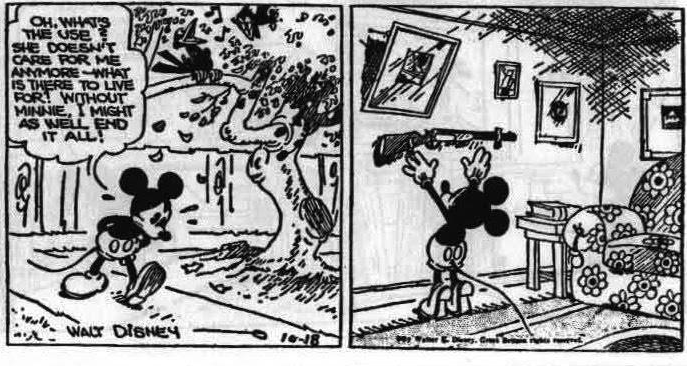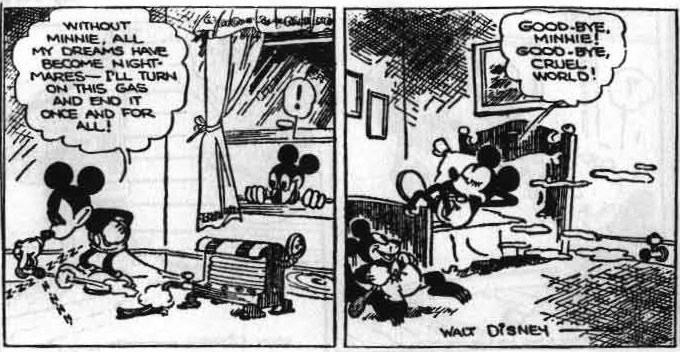Mickey Attempts Suicide

The two comic frames, above, were originally published in October of 1930, part of a two week story line. And yes, that’s a gun in the second frame. Mickey Mouse, Walt Disney’s iconic creation, is distraught, and looks to take his own life — a huge departure from the Mouse we know today.
It’s supposed to be comedy.
Mickey’s suicidal saga spanned a few days — four of them can be seen here. The plot: On the first day, Mickey catches Minnie cheating on him and, as seen above, decides to take his own life. For the next three days, he tries three different methods — shooting himself using a Rube Goldberg-esque setup to fire the rifle; jumping off a bridge; and poisoning himself with gas from his radiator (below) — and all three times, Mickey fails in what is intended to be a comical fashion. The rifle shot is interrupted by a cuckoo clock, with Mickey realizing that he’d be cuckoo to try and shoot himself. Mickey’s dive off the bridge lands him on a boat, where he becomes a de facto stowaway; the captain threatens to throw him overboard, and Mickey ironically begs him not to, as he can’t swim and will certainly drown. And Mickey’s asphyxiation fails when a squirrel-like character tries to fill a balloon with the gas, waking Mickey (who thinks he has just been shot). The humor is likely lost on modern audiences, but apparently, the depravity did not seem to concern audiences contemporary with the strips’ publication.

According to io9, the idea here was farce, not fatalism. A decade before the above comics ran, Walt Disney saw a silent movie, Haunted Spooks, which centered, comically, on the protagonist’s failed attempts at ending his own life. Disney thought the same joke would make for a good series of comics, and asked cartoonist Floyd Gottfredson to take a crack at it. Gottfredson initially objected, assuming that the newspaper publishing syndicate wouldn’t allow for such content, but Disney wanted to try it anyway.
Disney was proven correct. Not only were the comics published, but there’s no evidence that readers took any issue with the morbid storyline.
Bonus fact: Mickey’s failed attempt to drown himself in the gas of a leaky heater would, unfortunately, be a harbinger of things to come in Walt Disney’s life. In 1938, Walt and his brother Roy struck riches when their animated movie, Snow White and the Seven Dwarfs, grossed $8 million (well over $100 million in today’s dollars) in its first release. The brothers bought a new house for their parents, but their mother, Flora, complained about the furnace not working. Walt had it fixed, but the repairs were inadequate, and on November 6, 1938, Flora Call Disney died of asphyxiation from the furnace’s fumes.
From the Archives: Mickey Mask: How Mickey Mouse helped the Allied cause in World War II.
Related: Volumes 1 and 2 of classic Mickey Mouse cartoons, 624 pages. Want more? Volumes 3 and 4 are also available as a box set, adding another 560 pages of Mickey.
